Feel Good Lost
From Lake Plivtice we drove west over the coastal mountains and down to the Dalmatian seaside where the highway hugs the shore and fantastic views of the Adriatic Sea and nearby islands come rolling around with every point and harbor of the shoreline.
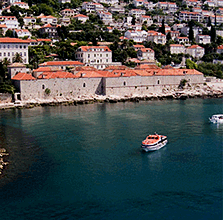 From the road I watched the cobalt seas specked occasionally with a yacht or fishing boat and forming a stark contrast with the red roof tiles of small villages and seaside hamlets such that, after a while, I had the sensation of having played too long with a color wheel, much the same way that staring at a word for too long can make one question the spelling. Eventually, after a four or five hour drive, we arrived at the seaside village of Dubrovnik.
From the road I watched the cobalt seas specked occasionally with a yacht or fishing boat and forming a stark contrast with the red roof tiles of small villages and seaside hamlets such that, after a while, I had the sensation of having played too long with a color wheel, much the same way that staring at a word for too long can make one question the spelling. Eventually, after a four or five hour drive, we arrived at the seaside village of Dubrovnik.
A walled trading city whose origins can be traced as far back as the 7th century and variously controlled by the Byzantines, Venetians and Turks, Dubrovnik is encircled by high walls and filled with narrow cobblestones streets and looks from above like an endless sea of mottled red and orange roof tiles.
Owing to a curious set of circumstances our original hotel was overbooked and we were forced to go to a nicer one which also gave me a private room (I hate it when that happens).  The Argentinean was very typically European, small rooms heavy draperies and most importantly an old and heavy cherry wood desk, the sort of desk where you could say sit down and get a bit of writing done. I am picky about only two things when it comes to writing, the desk my laptop sits on and/or, as the case may be, the pen I use. The wrong equipment often produces the wrong words, these things are important. Trust me.
The Argentinean was very typically European, small rooms heavy draperies and most importantly an old and heavy cherry wood desk, the sort of desk where you could say sit down and get a bit of writing done. I am picky about only two things when it comes to writing, the desk my laptop sits on and/or, as the case may be, the pen I use. The wrong equipment often produces the wrong words, these things are important. Trust me.
The downside to the Argentinean was its location, a bit of a walk from the old walled city, but after getting settled we set out for a stroll through old town. Dubrovnik’s old town area feels a bit like stepping back in time several centuries.
Most of the still standing buildings date from about 1468, though some were destroyed in the great earthquake of 1667, which leveled nearly everything on the Adriatic Sea. There are the remains of a monastery and nunnery, now merely crumbling walls and piled stones, which date from much early than the rest of the city, but by and large the city looks as it did in the fifteenth century. Long known as the Pearl of the Adriatic, many people think Dubrovnik is the most beautiful city in Europe and from what I’ve seen I believe them. 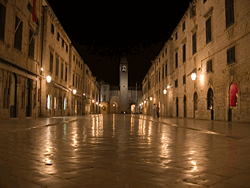 The downside of course is the resulting crowds, but most tourists seemed to be a bit older than me and for the most part headed home around ten. Insomniacs can have the place to themselves late at night and that’s when the city looks its best anyway, the polished stone streets reflect the glittering lamplight and no one is around.
The downside of course is the resulting crowds, but most tourists seemed to be a bit older than me and for the most part headed home around ten. Insomniacs can have the place to themselves late at night and that’s when the city looks its best anyway, the polished stone streets reflect the glittering lamplight and no one is around.
Dubrovnik is famous for its red tiled roofs. Apparently the tiles were unique, or perhaps just older than the other towns in the area, whatever the case nearly every photograph you’re likely to see of the city is from above looking out over the roofs. Regrettably Dubrovnik was heavily shelled during the Bosnian conflict and roughly 65 percent of its buildings were hit, thus Dubrovnik’s roofscape is not quite what it used to be. But to my eye it looked better with the new and slightly different tiles mottled together with older slightly yellower tiles. 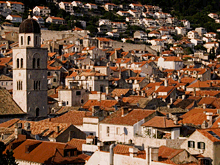 The contrast between the colors made the roofs look less a postcard perfect vision and more of an actual city. After all fairy tales are myth, reality looks a little more like someone parked a howitzer on the nearby hilltop and started lobbing injustice down on the world.
The contrast between the colors made the roofs look less a postcard perfect vision and more of an actual city. After all fairy tales are myth, reality looks a little more like someone parked a howitzer on the nearby hilltop and started lobbing injustice down on the world.
The next day we paid the rather exorbitant admission and set out to walk to walls. Dubrovnik’s walls range from a thickness of about four meters to as much as ten in some spots and comprise a distance of roughly two kilometers as they zigzag around the city. Walking the walls seemed a bit surreal to me. It would be more proper to say I staggered about the walls in a sort of trance owing to the fact that I had never actually seen a fairy tale city. As with most things that overwhelm me I found myself staring at the often mundane details instead, stockings hanging from a clothesline, a row of potted plants on a windowsill, an olive tree growing over a crumbling stone wall, a garden of lupines and morningbells growing out of an old tile roof. Perhaps the most surreal thing about Dubrovnik is that it still a functioning city and even as we tourists walked about the walls staring down at the narrow streets running off in all directions, 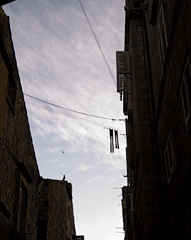 the people of Dubrovnik were tending their gardens and hanging out the days laundry or heading off to work. The sights from the walls looked like something out of a European children’s story and any given window may well have contained a princess I simply overlooked.
the people of Dubrovnik were tending their gardens and hanging out the days laundry or heading off to work. The sights from the walls looked like something out of a European children’s story and any given window may well have contained a princess I simply overlooked.
To the best of my knowledge she was not a princess, but I did meet a lovely Croatia woman one night who, along with a couple of her friends attempted to explain the Bosnia-Croatia-Serbian conflict to me. However, about half way through both Martina and her friend Marco seemed to lose track of the thread. It may have been the beer, it may have been simply that there are better things to do, but halfway through Marco kind of shrugged and said roughly ‘I don’t know, a bunch of assholes shot at us and we shot at them and then it stopped and now it’s history,’ which more or less covers it I believe.
I promised I would here mention that Marco and Martina had both recently moved to Dubrovnik to work at a lovely little ultra modern bar named Fresh which also serves various wraps and sandwiches by day. I only went out two nights in Dubrovnik (I had to make use of the lovely desk one night), but Fresh was by far the most fun. It’s the sort of spot that aimed both at travelers and locals though on the particular night I was there there were only three of us there and two were new employees which I think made the owner nervous. So I have done my part, if you’re in Dubrovnik, stop by Fresh and have a drink or two.
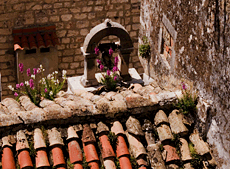 Dubrovnik was something out of a fairy tale, or at least that’s the only way I can contextualize it. I was thinking just the other day about American’s fascination with Europe (the number of Americans in Europe is staggering compared to what I saw in Asia. If only 6% of Americans have passports and therefore can leave the country, 5.99% of them come to Europe). I think part of what compels Americans in Europe is simply the idea that there is some history beyond the eighteen-century. Things as simple as that existence of buildings older than the 19th century is somewhat magical to those of us that come from a country whose history is so short. There may be a few old buildings in New York, but by and large American buildings are recent, which is something I don’t think Europeans can fully appreciate, surrounded as they are by everyday reminders of the past. We are new. We barely have a past.
Dubrovnik was something out of a fairy tale, or at least that’s the only way I can contextualize it. I was thinking just the other day about American’s fascination with Europe (the number of Americans in Europe is staggering compared to what I saw in Asia. If only 6% of Americans have passports and therefore can leave the country, 5.99% of them come to Europe). I think part of what compels Americans in Europe is simply the idea that there is some history beyond the eighteen-century. Things as simple as that existence of buildings older than the 19th century is somewhat magical to those of us that come from a country whose history is so short. There may be a few old buildings in New York, but by and large American buildings are recent, which is something I don’t think Europeans can fully appreciate, surrounded as they are by everyday reminders of the past. We are new. We barely have a past.
When the majority of European cities were being designed and built America was as yet unknown. Thus for an American to be in a city like Dubrovnik is something akin to stepping into a history book. For instance, near where I grew up one of the oldest areas is a city called Orange. Orange has an “old town” circle area whose buildings date from the early 1920s. This is about as far back as Southern California history goes. When I lived in Athens, GA there were a handful of antebellum mansions that date from more like the late 1700s, but nothing goes back further. To see anything that existed before 1700 is I think, for many Americans, a shocking revelation. Sure we know that Europe is there and it has all this old architecture, just like I know central America exists, but it won’t mean anything to me until I get there.
I’ve never really been one to dig too deep into the history of places, but something about Dubrovnik compelled me to. I spent the first evening digging around in a local bookshop and discovered that Dubrovnik can trace its history all the way back to the seventh century or so. But what I thought about later was not the actual history of Dubrovnik, but rather the realization that the longer I travel the more estranged I am from my own past and yet the more compelled I feel by history. Not that my past doesn’t matter to me, in fact it matters immensely since I see the present as a collision between yesterday and tomorrow, but my own history seems to me now more of something I read in a book than events that actually happened. I could not for instance tell you much about what I was thinking before I felt on this trip, but I could talk for hours about Jim Thompson and the silk trade of Thailand. I don’t remember what I did in Los Angeles last summer, but I know exactly when the Khmer Dynasty began construction on Angkor Wat.
When home fades, as it does when you travel, and your past begins to seem more like a secondhand memory, perhaps it’s only natural that you feel a bit lost and maybe my fascination with history is merely a grasping at straws to recover something I’ve lost. 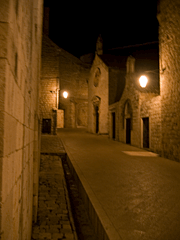 Perhaps this is the reason that expats gravitate toward each other, not because they feel some connection with home, but because they seek others who have lost that connection and the connection to the loss becomes their new home.
Perhaps this is the reason that expats gravitate toward each other, not because they feel some connection with home, but because they seek others who have lost that connection and the connection to the loss becomes their new home.
A friend of mine used to tell me that, owing to a childhood spent moving from town to town, she never felt like she really had a home. Someone recently wrote me in an email saying, much as Tom Wolfe’s novel You Can Never Go Home Again implies, once you’ve left you will forever feel like a foreigner no matter where you may go. It’s a difficult feeling to explain except to say that the further you go, through both time and space, the less you feel connected to anything that happened before you left.
But that’s not to say I’ve forgotten you my friends, people remain every bit as real, it’s the events that fade, the mindset that changes. And it isn’t a bad thing, on the contrary I find it quite liberating. I am without a doubt happier traveling than I ever have been at home. For the first time in my life, on this trip, I feel like I’m doing what I am supposed to be doing. And it feels good.
Many people have written to ask what I plan to do when I get home. My quick answer is always, leave again. It may seem like I’ve been all over the place on this trip, but from my point of view I’ve merely revealed how little I’ve seen. The past, something called home, seems at this point unreal. There is so much of my own past that no longer fits in the present and I fear, as my friend said, that I will forever be a stranger in my own land.
And yet if anything becomes more real without a past, it’s a connection to the present. It has become trite, that Buddhist saying, be here now, but now is where we live and no matter what you do you can’t live in the past or the future, so indeed you may as well be here now and learn, as I am trying to do, how to feel good lost.
Thoughts?
Please leave a reply:
All comments are moderated, so you won’t see it right away. And please remember Kurt Vonnegut's rule: “god damn it, you’ve got to be kind.” You can use Markdown or HTML to format your comments. The allowed tags are
<b>, <i>, <em>, <strong>, <a>. To create a new paragraph hit return twice.